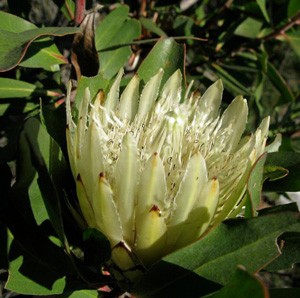Wagon tree
(Leucadendron nitidum)

Description
Protea nitida, commonly called wagon tree, waboom or blousuikerbos, is a large, slow-growing Protea endemic to South Africa. It is one of the few Protea species that grows into trees, and the only one that has usable timber. The natural range of Protea nitida is from the Cape Peninsula, all the way to the Bokkeveld escarpment and into the Eastern Cape. It grows on mountain slopes of all altitudes and in the right conditions, they can form large open woodlands. Though they are not threatened, in many areas they have been cleared for timber, often to be replaced by commercial pine plantations. Protea nitida is a slow-growing tree, with very thick white-grey bark, that varies considerably in height. It is normally about 5 meters tall, but in good conditions it may reach a height of up to 10 meters, with a trunk diameter of 1 meter. The young leaves are crimson, but they become a bluish, sea-green colour in later life. These leaves are described as "oblong to elliptic", "hairless" and "leathery". Large, bisexual flower heads appear all through the year, especially in winter, and bear sweet nectar. Small nuts are released about a year after flowering. Throughout their distribution, a dwarf, multi-stemmed form with narrow green leaves also occurs—at one point regarded as a distinct species, Protea reticulata. The common name wagon tree and waboom originates from the use of its wood in making wagon wheels pre-1800. Protea is a genus of South African flowering plants, also called sugarbushes (Afrikaans: suikerbos). Most proteas occur south of the Limpopo River. However, Protea caffra kilimandscharica is found in the chaparral zone of Mount Kenya National Park. About 92% of the species occurs only in the Cape Floristic Region, a narrow belt of mountainous coastal land from Clanwilliam to Grahamstown, South Africa. The extraordinary richness and diversity of species characteristic of the Cape flora are thought to be caused in part by the diverse landscape, where populations can become isolated from each other and in time develop into separate species. The family Proteaceae to which Protea species belong is an ancient one among angiosperms. Evidence from pollen fossils suggests Proteaceae ancestors grew in Gondwana, in the Upper Cretaceous, 75–80 million years ago.
Taxonomic tree:







